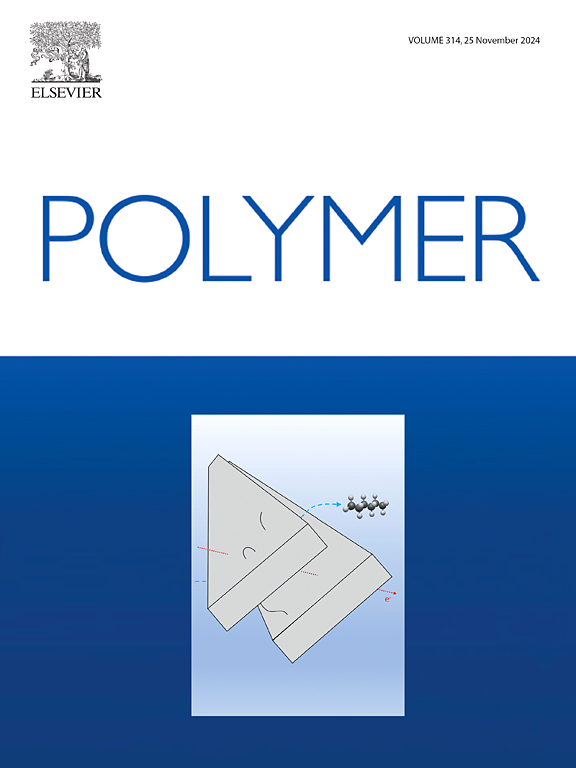π-bridge-engineered naphthalenediimide copolymers for all-polymer photodetectors with high specific detectivity
IF 4.5
2区 化学
Q2 POLYMER SCIENCE
引用次数: 0
Abstract
Conjugated acceptor polymers have emerged as promising candidates for all-polymer photodetectors (all-PPDs). However, precise molecular structure modulation remains essential to optimize their optoelectronic properties for specific applications. Recent advances have led to a shift from homopolymers to donor-acceptor (D-A) conjugated copolymers to improve device performance. Notably, dual-acceptor architectures(A1-D-A2-D) have shown potential in extending absorption spectra through synergistic electronic effects. In this study, three naphthalenediimide (NDI)-based acceptor polymers with thienopyrrodione (TPD) as the secondary acceptor moieties were designed and prepared via direct arylation polymerization: P(NDI-TPD) (dual-acceptor), P(NDI-T-TPD) (single thiophene π-bridge), and P(NDI-TT-TPD) (thieno[3,2-b] thiophene π-bridge). Systematic investigations revealed that π-bridge engineering significantly modulates molecular planarity, charge delocalization, and energy level alignment. When blended with donor polymers J71 or PTB7-Th, PTB7-Th:P (NDI-TT-TPD)-based devices exhibited broadest response range (300–800 nm) with a peak responsivity of 238.3 mA W−1 and a maximum specific detectivity of 4.9 × 1013 Jones at a bias voltage of −0.1 V. The combination of exceptional linear dynamic range (71.8 dB) and microsecond-scale response speed further validates their potential in real-time imaging systems. This work establishes π-bridge engineering as a powerful strategy for developing high-performance all-PPDs, providing fundamental guidelines for molecular design of conjugated acceptor polymers with tailored optoelectronic properties.


高比探测全聚合物光电探测器用π桥工程萘二酰亚胺共聚物
共轭受体聚合物已成为全聚合物光电探测器(all-PPDs)的候选材料。然而,精确的分子结构调制对于优化其特定应用的光电性能仍然至关重要。最近的进展导致了从均聚物到供体-受体(D-A)共轭共聚物的转变,以提高设备性能。值得注意的是,双受体结构(A1-D-A2-D)显示出通过协同电子效应扩展吸收光谱的潜力。本研究以噻吩吡咯二酮(TPD)为二级受体基团,通过直接芳基化聚合,设计并制备了三种萘二酰亚胺(NDI)基受体聚合物:P(NDI-TPD)(双受体)、P(NDI- t -TPD)(单噻吩π桥)和P(NDI- tt -TPD)(噻吩[3,2-b] π桥)。系统研究表明,π桥工程对分子平面度、电荷离域和能级排列有显著的调节作用。当与给体聚合物J71或PTB7-Th混合时,PTB7-Th:P (NDI-TT-TPD)基器件的响应范围最宽(300-800 nm),峰值响应率为238.3 mA·W-1,在偏置电压为-0.1 V时的最大比检出率为4.9×1013 Jones。卓越的线性动态范围(71.8 dB)和微秒级响应速度的结合进一步验证了它们在实时成像系统中的潜力。本研究建立了π桥工程作为开发高性能全ppd的有力策略,为具有定制光电性能的共轭受体聚合物的分子设计提供了基本指导。
本文章由计算机程序翻译,如有差异,请以英文原文为准。
求助全文
约1分钟内获得全文
求助全文
来源期刊

Polymer
化学-高分子科学
CiteScore
7.90
自引率
8.70%
发文量
959
审稿时长
32 days
期刊介绍:
Polymer is an interdisciplinary journal dedicated to publishing innovative and significant advances in Polymer Physics, Chemistry and Technology. We welcome submissions on polymer hybrids, nanocomposites, characterisation and self-assembly. Polymer also publishes work on the technological application of polymers in energy and optoelectronics.
The main scope is covered but not limited to the following core areas:
Polymer Materials
Nanocomposites and hybrid nanomaterials
Polymer blends, films, fibres, networks and porous materials
Physical Characterization
Characterisation, modelling and simulation* of molecular and materials properties in bulk, solution, and thin films
Polymer Engineering
Advanced multiscale processing methods
Polymer Synthesis, Modification and Self-assembly
Including designer polymer architectures, mechanisms and kinetics, and supramolecular polymerization
Technological Applications
Polymers for energy generation and storage
Polymer membranes for separation technology
Polymers for opto- and microelectronics.
 求助内容:
求助内容: 应助结果提醒方式:
应助结果提醒方式:


